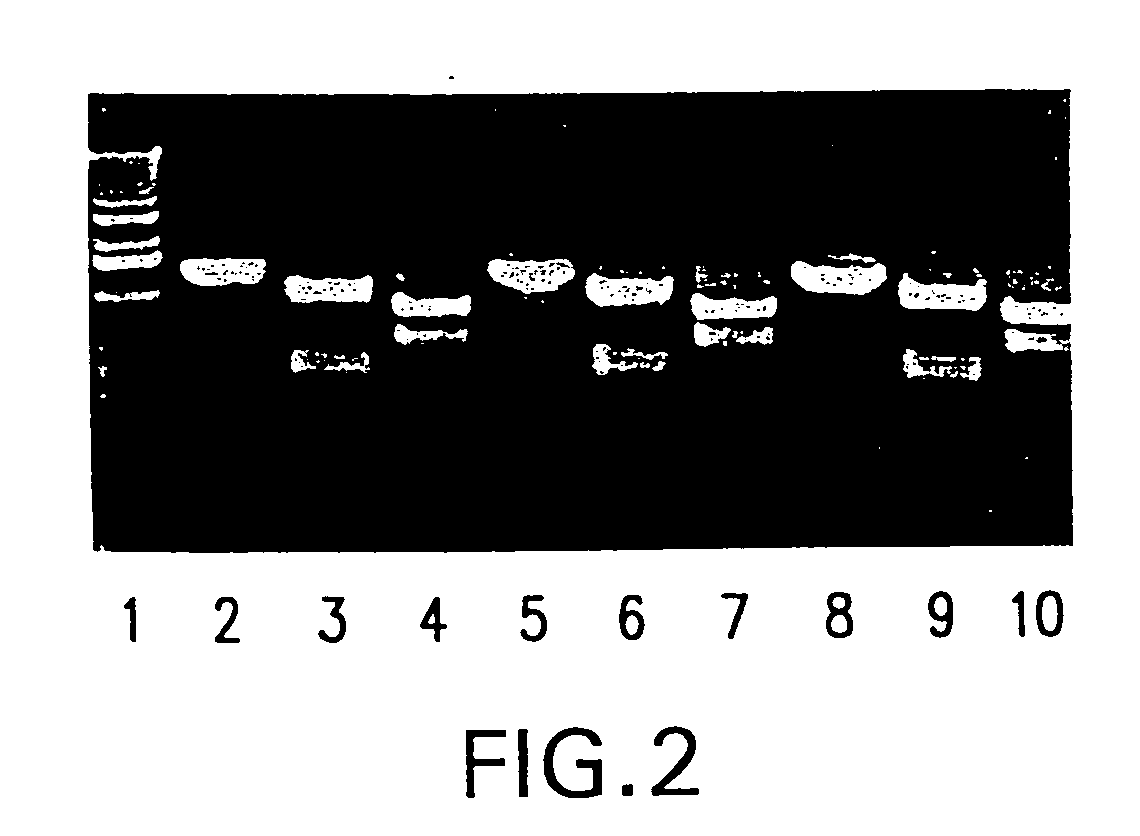Recombinant parainfluenza virus expression systems and vaccines
a technology of parainfluenza virus and expression system, which is applied in the field of recombinant parainfluenza virus (piv) cdna or rna, can solve the problems of difficult replication of all negative-strand rna viruses, including piv, and the absence of effective antiviral therapy
- Summary
- Abstract
- Description
- Claims
- Application Information
AI Technical Summary
Benefits of technology
Problems solved by technology
Method used
Image
Examples
example 1
6. EXAMPLE 1
Construction and Cloning of Chimeric Bovine Parainfluenza 3 / Human Parainfluencza 3 cDNA
[0100] For the purpose of interchanging the F and HN genes of bPIV3 with those of hPIV3, additional restriction enzyme sites were introduced into the infectious bPIV3 cDNA. Using site-directed mutagenesis, a unique Nhe 1 site was introduced at nucleotide position 5041 and a Sal 1 site was introduced at nt 8529 in the bPIV3 cDNA. The modified full-length bPIV3 cDNA was treated with Nhe 1 and Sal 1 and a .about.14 kb DNA fragment encompassing all of the viral bPIV3 sequences except the F and HN genes, was isolated by gel purification.
[0101] To obtain the hPIV3 F and HN gene sequences, a 10 cm dish of confluent Vero cells was infected with hPIV3 / Tex / 12084 / 1983. After 3 days of incubation at 37.degree. C., the cells. were harvested and total RNA was isolated using RNA STAT-LS 50 (Tel-Test Inc.). Viral cDNA was generated by reverse transcription using a hPIV3 specific oligo annealing at pos...
example 2
7. EXAMPLE 2
Rescue of Chimeric Bovine Parainfluenza Type 3 / Human Parainfluenza Type 3 Virus in HeLa Cells and Vero Cells
[0103] Rescue of the chimeric bPIV3 / hPIV3 virus was done using a similar procedure as for bPIV3 rescue. Rescue of bPIV3 / hPIV3 chimeric virus by reverse genetics was carried out in HeLa cells using LipofecTACE (Gibco / BRL). The 80% confluent HeLa cells or Vero cells were infected with MVA at an MOI of 4. One hour post-infection, the full-length anti-genomic bPIV3 / hPIV3 cDNA (4 .mu.g) was transfected into the infected HeLa or Vero cells together with the NP (0.4 .mu.g), P (0.4 .mu.g), and L / pCITE (0.2 .mu.g) expression plasmids. Forty hours post-transfection, the cells and the cell supernatant were harvested (P0) and subjected to a single freeze-thaw cycle. The resulting cell lysate was then used to infect a fresh Vero cell monolayer in the presence of 1-beta-D-arabinofuranosylcytosine (ara C), a replication inhibitor of vaccinia virus, to generate a P1 virus stock. T...
example 3
8. EXAMPLE 3
Confirmation of Chimeric Bovine Parainfluenza Type 3 / Human Parainfluenza Type 3 Virus Rescue By RT-PCR
[0104] To ascertain that the rescued virus is chimeric in nature, i.e. the virus contains hPIV3 F and HN gene sequences in a bPIV3 backbone, the viral RNA genome was analyzed further by RT-PCR. Vero cells, infected with the P1 virus stock of three independently derived isolates of bPIV3 / hPIV3 were harvested and total RNA was isolated. The viral RNA was amplified using an oligo that anneals at position 4757 of bPIV3. A viral region from nt 5255 to 6255 was amplified by PCR. The resulting 1 kb PCR fragment should contain hPIV3 sequences. This was confirmed by digestion with enzymes (Sacl and Bgl II) specific for hPIV3 and that do not cut in the complementary region of bPIV3 (see FIG. 1). As expected, Sac l and Bgl II cut the PCR fragment into smaller fragments confirming that the isolated sequences are derived from hPIV3 (see lanes 3, 5, 7). In addition, a region in the po...
PUM
 Login to View More
Login to View More Abstract
Description
Claims
Application Information
 Login to View More
Login to View More - R&D
- Intellectual Property
- Life Sciences
- Materials
- Tech Scout
- Unparalleled Data Quality
- Higher Quality Content
- 60% Fewer Hallucinations
Browse by: Latest US Patents, China's latest patents, Technical Efficacy Thesaurus, Application Domain, Technology Topic, Popular Technical Reports.
© 2025 PatSnap. All rights reserved.Legal|Privacy policy|Modern Slavery Act Transparency Statement|Sitemap|About US| Contact US: help@patsnap.com


